- Flowers
Flower Bulbs Allium Bulbs Anemones Begonia Tubers Crocus Bulbs Daffodil Bulbs Dahlia Tubers Hyacinth Bulbs Lily Bulbs Tulip Bulbs Woodland Flower Bulbs Other Flower BulbsFlower Plants Annual Bedding Plants Children's Flower Plants Clematis Climbing Plants Cottage Garden Plants Exotic Plants Flowers For Cutting Plants Foliage Plants Greenhouse & Indoor Plants Ground Cover Plants Hanging Basket Plants Lavender PlantsHardy Geraniums Herbaceous Border Plants Heuchera Pansies and Violas Patio Plants Water Plants Window Box Plants Winter Bedding Plants Hydrangea Large impact plants Recommended By Our Experts
- Fruit & Vegetables
- Trees, Shrubs & Ornamentals
- House Plants
- Tool Shed
Garden Tools & Equipment Barrows and Trolleys Garden Solutions Harvesting Plant Supports Seed Sowing Tree Stakes Water Butts Weed Control Hand Tools Secateurs, Snips and Pruners WorkshopGarden Irrigation & Watering Irrigation Kits Water Butts Hoses & Sprays Miscellaneous Fertilisers Plant Pots Hanging Baskets Plant Protection Garden Compost All Compost
- Outdoor Living
Garden Living Barbecues & Firepits Garden Storage Solar Lights & Lighting Fixtures & Ornaments Awnings Sail Shades Garden Clocks Landscaping Lawn Edging PavingPatio Heaters Gas Patio Heaters Electric Patio Heaters Fire Pits, Chimeneas, Fire Baskets Wallmounted/Ceiling Patio Heaters Freestanding/Table Top Patio Heaters Water Features Solar Powered Water Features Mains Powered Water Features Indoor Water Features Outdoor Water FeaturesGarden Furniture Rattan Furniture Parasols Garden Benches Dining Sets Loungers Wooden Furniture Party Tents & Gazebos
- Wild Birds
- Gardening Info
- Special Offers
Join Our Gardening ClubVan Meuwen Gardening Club
Become a Member
Join our Gardening Club to unlock exciting perks and discounts!
JUST £10 for one year's membership
10% OFF EVERY order placed online £20 worth of Van Meuwen Vouchers Exclusive members only deals Join NowTop ten climbing plants
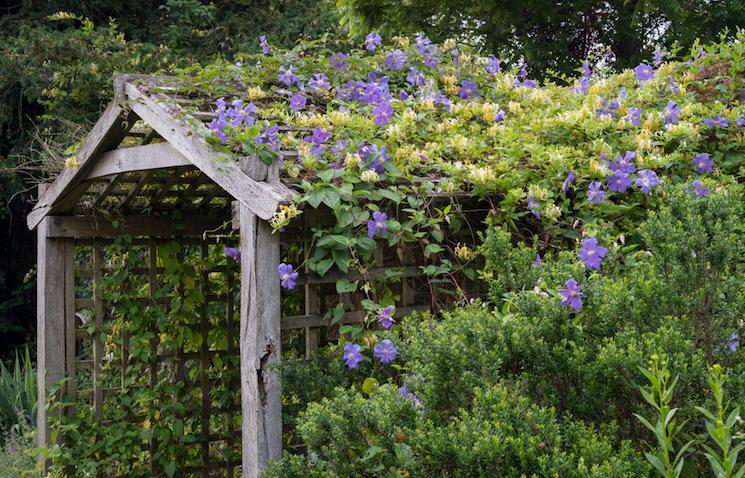
Brighten your walls and fences with beautiful climbing plants
Image: Mark HeighesClimbing plants are a wonderful way to brighten walls and fences, and give trellises, pergolas, and gazebos a real wow factor. But with such a wide range of climbers to choose from, what do you go for? To help you make the right decision, here’s our collection of ten of our favourites we think you’ll love.
Clematis
Thinking of planting clematis? Clematis come in all shapes and sizes making them a really versatile option for decorating walls and fences.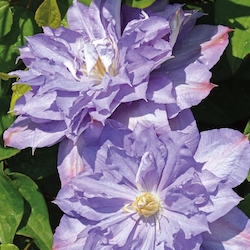
Clematis like sun and semi-shade and don’t like to get too dry – remember to add well rotted manure or other organic matter to soil before planting. Grow clematis against a trellis, obelisk or similar support structure and get ready to enjoy a great display.Cape Leadwort
Superb as a patio climber, or for your conservatory, tender evergreen Cape Leadwort is happy in temperatures down to around 5°C, and with its unusual blue flowers makes an excellent garden talking point.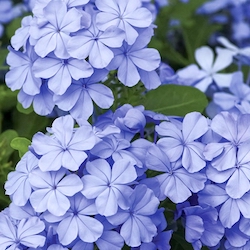
Grow plumbago auriculata – a native of South Africa – in a large container and train it over a trellis. Enjoy a profusion of delicate clumps of blooms from mid May through to the middle of October before moving the plant inside for the winter. Cape Leadwort likes a sunny spot and a monthly feed during the growing season.Jasmine
Richly scented Jasmine makes a wonderful addition to any garden planting scheme. A brisk climber, it soon covers fences, trellises, walls and tree stumps, providing excellent coverage and, with its delicate star-shaped cream flowers, a wonderful display too.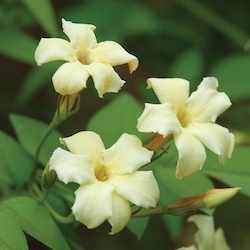
Plant your jasmine where you can smell it – by the kitchen door, or on the wall or fence behind your garden seat are good options. Bring your plug plants on before planting in a sunny spot that’s protected from chill winds during the winter. Enjoy Jasmine ‘clotted cream’ from mid May to September.Honeysuckle
Spring and summer wouldn’t be the same without the sweet scent of honeysuckle. This cottage garden favourite really is a must, and it’s a hit with wildlife too. Bumblebees prize honeysuckle nectar, lapping it up during the daytime, and at night, when the flowers are at their most fragrant, it’s moths who come to the banquet.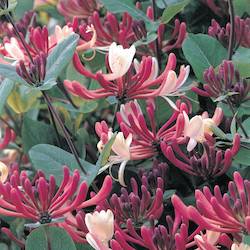
This delightful honeysuckle 'Belgica' blooms from mid April to mid June and, if you’re lucky, will bloom again during the autumn. Plant honeysuckle in moist, well-drained soil in sun or semi shade, remembering to provide a trellis or wires for support – or alternatively, grow it through existing trees and shrubs.Wisteria
A classic climber from the Far East and the Eastern USA, grow this Chinese wisteria by training it up a wall, or as a small weeping tree. Like all wisteria, this plant needs sturdy support and careful pruning, but come spring and early summer, your work will pay off handsomely in the form of a profusion of scented lilac pendants.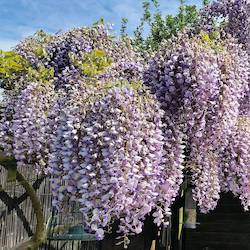
Wisteria plants like a sunny spot where the soil is well-drained, but won’t dry out. Choose a sheltered position where the frost won’t damage the flower buds, add plenty of well-rotted organic matter to the soil before planting, and water regularly especially when newly planted and during dry spells.Ivy
The Victorians loved ivy so much they even grew it indoors, training it over metal supports to create living archways. These days, it’s much in demand again, bringing evergreen colour and cover to unsightly garage walls and fences.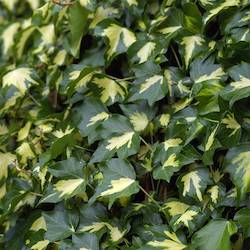
With its unique ‘golden heart’ ivy hedera helix adds the wow factor to shady corners. Ideal for those whose gardens face away from full sun, ivy is dead easy to grow especially in alkaline soils. Enjoy a mass of yellow-green flowers in autumn, then black fruits that will help keep songbirds well fed during the winter.Snail tree
Looking for something a little different? Sollya heterophylla is better known as the Bluebell Creeper. This Australian native enjoys warm conditions so its perfect for brightening up your conservatory, or grown as a patio plant in summer. The dangling, deep blue flowers stand out beautifully against a cloak of evergreen foliage.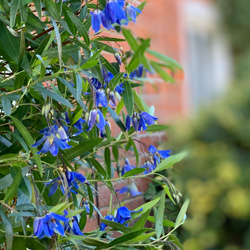
This elegant, twining climber always attracts attention for its natural good looks. With a neat and compact habit, it is best grown in a container that can be moved indoors for the winter and back outside in summer.
Trumpet vine
With their gloriously exotic flowers, campsis or 'trumpet vines' look positively tropical but are hardy plants that grow well here in the UK. Clinging to walls, fences, and pergolas, campsis climbs as high as an astonishing 12m and produces a vibrant display of bright red trumpet-shaped flowers through late summer and autumn.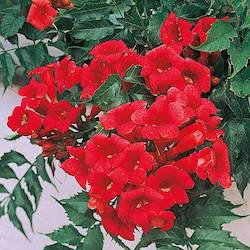
Despite being hardy, a sunny position in your garden that’s also sheltered from cold winds helps campsis give you its best performance. Trumpet vines like a moist but well-drained soil – if you’re growing yours in pots, go for a good general purpose compost like John Innes No. 2, and add grit to help with drainage.Passion flowers
For a flamboyant flowering climber that’s not too fussy about soil type, look no further than the passion flower. You’ll love these vigorous climbers, which deliver an exotic display of blooms followed by large fruits for a knockout display from mid June to mid September.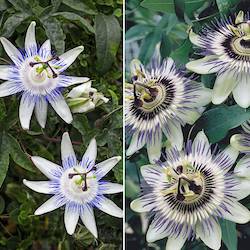
Passion flowers like a warm south or southwest-facing wall best and will thrive in any reasonably fertile soil. To get the best from your plants, dig plenty of well rotted manure into the ground before planting, and provide adequate support for the twining stems.Climbing Fuchsias
Fuchsias aren't just for your hanging baskets! Now you can train them upwards to create a showy vertical display. Climbing Fuchsias are specially bred for their super-long stems. These vigorous plants aren't natural climbers so they won't cling to supports on their own. Simply tie the stems onto a framework of trellis or an obelisk to create a showstopping focal point that will flower all summer.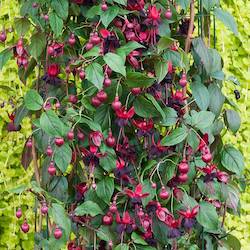
Fuchsias are a great way to add interest to beds, borders, and containers and, when you train them, they’ll grow to about six feet, making them an excellent mid-height plant. Plant them in sun or semi shade, and for best results, choose a spot that provides shelter from icy winter blasts.Sign up to the Van Meuwen Gardener's Club for Special Offers
Delivery Information Privacy Policy Cookies Terms of Business Affiliate Programme Planting & Cultural Advice Contact Us© 2025 Van Meuwen. All rights reserved. A division of Branded Garden Products Limited.

- House Plants
